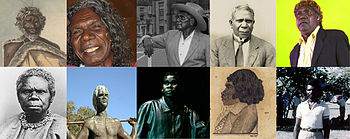IND/Racial Thinking and Indigenous Histories

Top row: Windradyne (File:Windradyne, Aust. Aboriginal warrior from the Wiradjuri.jpg), David Gulpilil(File:David Gulpilil.jpg), Albert Namatjira (File:Namatjira govt house sydney.jpg), David Unaipon (File:David Unaipon.jpg), Mandawuy Yunupingu (File:201000 - Opening Ceremony Yothu Yindi perform 2 - 3b - 2000 Sydney opening ceremony photo.jpg)
Bottom row: Truganini (File:Trugannini 1866.jpg), Yagan (File:Yagan Statue Head.jpg), Geoffrey Gurrumul Yunupingu (File:Geoffrey Gurrumul Yunupingu in Nov 2012.jpg), Bennelong (File:Bennelong.jpg), Robert Tudawali (File:Robert Tudawali at Darwin's Bagot Reserve 1960.jpg)
As violence, disease and dispossession led to population decline, in the late nineteenth and twentieth centuries non-Indigenous people came to see Indigenous people as a ‘dying race’, and policies were implemented based on the assumption that Indigenous people would soon ‘die out’. These ideas were also justified by the development of scientific thought about human difference and increasingly hardened views about the role of ‘race’ to explain human difference.
The publication of Charles Darwin’s The Origin of Species in 1859 led to a revolution in science, marking the development of ideas about evolution. While Darwin’s early work did not really mention people, his ideas soon began to be translated to human society, and became used to explain differences between people. ‘Social Darwinism’ suggested that:
- human groups or ‘races’ had evolved through Darwinian processes of natural selection and ‘survival of the fittest’;
- that cultural differences had arisen out of genetic differences; and
- that the various ‘races’ of the world are at different stages on a vertical evolutionary scale with dark-skinned ‘races’ being closer to primates at the lower end and the white European ‘race’ closer to human physical and cultural perfection at the top.
These ideas had a strong influence on non-Indigenous thinking in Australia about ‘race’ and about Indigenous people. A work of anthropology, Kamilaroi and Kurnai (1880), written by explorer and public servant A. W. Howitt and missionary Lorimer Fison, is one of the earliest Australian works to show the impact of this thinking. Here is a quote from the preface to the book, written by an American anthropologist, which explains what the significance of the work was considered to be:
| “ | In a lower ethnical condition than [First Nation American peoples, Indigenous Australians] now represent the condition of mankind in savagery better than it is elsewhere represented on the earth – a condition now rapidly passing away, through the destructive influence of superior races. Moreover, it is a condition of society which… is one of the stages of progress through which the more advanced tribes and nations of mankind have passed in their early history (Morgan, 1880, as cited in McGregor, 1997, pp. 34-35). | ” |
Most contemporary observers throughout this period believed that Aboriginal people would ‘die out’, probably in the near future. This sentiment was most famously expressed in Daisy Bates’s book, The Passing Of The Aborigines (1938). The idea that Indigenous people were ‘rapidly passing away’ led to policies to ‘protect’ Indigenous people by moving people to reserves and missions where non-Indigenous authorities and missionaries would ‘smooth the dying pillow’. We see this idea clearly in the words of Bates, an eccentric ‘philanthropist’ and amateur anthropologist who worked amongst Indigenous people first in Western Australia and later in South Australia. In 1907, as part of a lecture delivered to the Australian Governor-General, Bates stated “it should never be forgotten that we are dealing with a dying race” and that non-Indigenous people should do “all that can be done is to render their passing easier” (Bates, as cited in McGregor, 1997, p. 55). Bates went on to state:
| “ | The Aboriginals [sic] of southern Australia... are from their primitiveness and inability to assimilate the new civilization, so rapidly passing out of existence.
The northern natives are disappearing more slowly but none the less surely - … their ultimately extinction is also but too certain… to save and civilize the race we are supplanting is an impossibility, for they are physically uncivilizable, and are inevitably doomed to perish” (Bates, 1907, as cited in McGregor, 1997, pp. 55-56). |
” |
These ideas came to be expressed through ‘Protection’ legislation aimed to ‘protect’ so-called ‘full blood’ Indigenous people from the perceived negative effects of contact with non-Indigenous people and to leave Indigenous people in peace until it was thought that they would inevitably become extinct. As we will discuss next week, ‘Protection’ policies also allowed the removal of children who had an Indigenous and non-Indigenous parent to be brought up within non-Indigenous society. Social Darwinism fed European ethnocentrism and lent ‘scientific’ support to the dominant political ideas and endeavours of the day. In Australia, it provided the British with ‘evidence’ as to their biological and cultural superiority over Aboriginal people. In this way, Social Darwinism and the concept of ‘race’ provided justification for the denial of Indigenous rights and humanity.